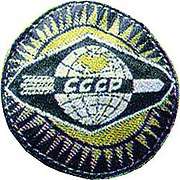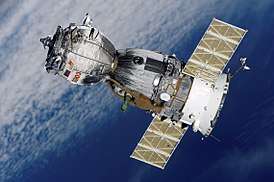Soyuz 9
Soyuz 9 (Russian: Союз 9, Union 9) was a 1970 Soviet crewed space flight. The two-man crew of Andrian Nikolayev and Vitali Sevastyanov broke the five-year-old space endurance record held by Gemini 7, with their nearly 18-day flight. The mission paved the way for the Salyut space station missions, investigating the effects of long-term weightlessness on crew, and evaluating the work that the cosmonauts could do in orbit, individually and as a team. It was also the last flight of the first-generation Soyuz 7K-OK spacecraft, as well as the first crewed space launch to be conducted at night. To date, Soyuz 9 marks the longest crewed flight by a solo spacecraft.
| Operator | Soviet space program |
|---|---|
| COSPAR ID | 1970-041A |
| SATCAT no. | 4407 |
| Mission duration | 17 days, 16 hours, 58 minutes, 55 seconds |
| Orbits completed | 288 |
| Spacecraft properties | |
| Spacecraft type | Soyuz 7K-OK |
| Manufacturer | Experimental Design Bureau OKB-1 |
| Launch mass | 6,590 kilograms (14,530 lb) |
| Crew | |
| Crew size | 2 |
| Members | Andrian Nikolayev Vitaly Sevastyanov |
| Callsign | Сокол (Sokol – "Falcon") |
| Start of mission | |
| Launch date | 1 June 1970, 19:00:00 UTC |
| Rocket | Soyuz |
| Launch site | Baikonur 31/6[1] |
| End of mission | |
| Landing date | 19 June 1970, 11:58:55 UTC |
| Landing site | 50°N 72°E |
| Orbital parameters | |
| Reference system | Geocentric |
| Regime | Low Earth |
| Perigee altitude | 176 kilometres (109 mi) |
| Apogee altitude | 227 kilometres (141 mi) |
| Inclination | 51.6 degrees |
| Period | 88.5 minutes |
 Soyuz programme (Crewed missions) | |
Crew
| Position[2] | Cosmonaut | |
|---|---|---|
| Commander | Andrian Nikolayev Second and last spaceflight | |
| Flight Engineer | Vitaly Sevastyanov First spaceflight | |
Mission highlights
.jpg)
Commander Andriyan Nikolayev and flight engineer Vitaly Sevastyanov spent 18 days in space conducting various physiological and biomedical experiments on themselves, but also investigating the social implications of prolonged spaceflight. The cosmonauts spent time in two-way TV links with their families, watched matches in the 1970 FIFA World Cup, played chess (including this chess game with the crew as white; it was the first chess game played across space) with ground control, and voted in a Soviet election. The mission set a new space endurance record and marked a shift in emphasis away from spacefarers merely being able to exist in space for the duration of a long mission (such as the Apollo flights to the Moon) to being able to live in space.
The mission took an unexpected physical toll on the cosmonauts; in order to conserve attitude control gas during the lengthy stay in orbit, Soyuz 9 was placed in a spin-stabilization mode that made Nikolayev and Sevastyanov dizzy and space sick. When landing finally came, they required help exiting the descent module[3] and were virtually unable to walk for a few days. Nonetheless, this experience proved the importance of providing crews with exercise equipment during missions.
After landing the crew spend 2 weeks in a quarantine unit originally designed for cosmonauts returning from moon landings.[3] While at the time the soviet press reported this was done in order to protect the cosmonauts in case space travel had weakened their immune system in practice its more likely it was practice for the Soviet crewed lunar program which at that point had not been abandoned.[3]
Mission parameters
- Mass: 6590 kg (14,530 lb)
- Perigee: 176 km (109 mi)
- Apogee: 227 km (141 mi)
- Inclination: 51.6°
- Period: 88.5 min
See also
References
| Wikimedia Commons has media related to Soyuz 9. |
- "Baikonur LC31". Encyclopedia Astronautica. Retrieved 2009-03-04.
- Mir Hardware Heritage – 1.7.3 (wikisource)
- Harvey, Brian (2007). Soviet and Russian Lunar Exploration. Springer-Praxis. pp. 179–181. ISBN 0387218963.
